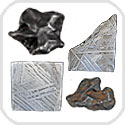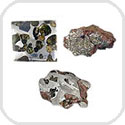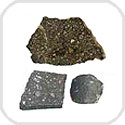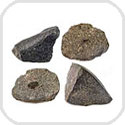When a person buys a meteorite for sale, it is unlike purchasing anything else on the planet because they are space rocks that come from outer space, not man-made objects or a type of Earth rock. This guide presents useful information to help you in the purchase of your first meteorite. As you learn more about meteorites and start building your collection, you will develop your own methods for deciding on the specific types of meteorites to have in your collection.
First, there are many different categories of meteorites. One has to decide if they are going to buy an iron meteorite, stone meteorite, or perhaps a pallasite from the stony iron family of meteorites. This meteorite guide will help you not only learn more, but will help you choose which of the many types of meteorites to purchase.
Meteorites are stones that have fallen to Earth from space. Meteorites are rare stones far scarcer than diamonds. Throughout history meteorites have been revered as special, often thought of as gifts from the heavens. Only in the last 500 years has the truth of the origin of meteorites been known. Meteorites are broken off pieces of asteroids that have wandered our Solar System for countless eons. As with any collectible including meteorites for sale, it is important to know the authenticity. The Meteorite Exchange Inc. only sells genuine meteorites obtained from a select group of the world’s finest meteorite hunters and dealers.
Buy Meteorites By Price
Our meteorites by price table is designed to speed your meteorite buying journey. Whether you’re an amateur collector or a seasoned enthusiast, our intuitive price range button table is here to guide you in finding the perfect meteorite within your budget.
With just a simple click, you can explore a sorted selection of meteorites categorized by price range, ensuring that you find the celestial treasure that suits your preferences.
 Lunar Meteorites
Lunar Meteorites  Martian Meteorites
Martian Meteorites
Lunar Meteorites and Martian Meteorites are stones that arrived on Earth from impacts on The Moon and Mars. Small quantities of the huge amount of material blasted off during the impacts have escaped and wandered in space until being caught by the Earth’s gravity. The stones are later found as exceptionally rare meteorites. Their origins on the Moon or Mars have been confirmed through intensive analysis in laboratories using amongst other evidence Apollo Moon Rocks and Martian atmospheric isotopes as references. The origins of Lunar Meteorites and Martian Meteorites are well confirmed today.
Mars Meteorites By Price
 Iron Meteorites
Iron Meteorites
Iron Meteorites come from the broken metal cores of destroyed asteroids. Made almost entirely of solid nickel-iron metal iron meteorites display beautiful internal structures when polished and etched. Iron Meteorites such as Canyon Diablo, and Henbury have great stories and have been known by mankind for a long time. It happens that both of these are from crater forming events. Both often have great shapes and are pretty easy to maintain for display. Canyon Diablo Meteorites are often the first meteorite that a new collector will get. They come from the famous Meteor Crater in central Arizona. It is not permitted to gather meteorites from around the crater today. But, thousands of meteorites were collected during the last century and are still being sold and resold today. Henbury Meteorites come from a crater in Australia. They are a wonderful meteorite also nicely sculptured by the tearing forces of the impact.
 Stony-Iron Meteorites
Stony-Iron Meteorites
Stony-Iron Meteorites are the family of meteorites represented by the Pallasites and the Mesosiderites. Stony-Iron Meteorites contain approximately half nickel-iron metal. In the case of the Pallasites, the other portion is olivine crystals, the same mineral as peridot the semiprecious gemstone. Pallasites are beautiful extraterrestrial jewels once sliced to expose their crystals and look quite amazing with back lighting.. Mesosiderites contain silicate minerals in addition to the one-half nickel-iron. Mesosiderites often have fascinating textures as a result of the mixing of stone and metallic materials.
 Achondrite Meteorites
Achondrite Meteorites
Achondrite Meteorites are meteorites without chondrules. Achondrites come from larger asteroids where minerals melted by pressure within the asteroid or where surface collisions resulted in the melting of asteroid material. The giant asteroid Vesta is believed to be the parent body for many achondrites of the Howardite, Eucrite, and Diogenite families of meteorites. Achondrites have been heated more and have often formed by different processes than the Chondrites. There are many subgroups of Achondrites.
 Carbonaceous Chondrite Meteorites
Carbonaceous Chondrite Meteorites
Carbonaceous Chondrite Meteorites have chondrules but also have the element carbon in their composition. Some Carbonaceous Chondrites contain organic compounds and primitive protein molecules. This class of meteorites is especially important to research scientists. Carbonaceous meteorites are among the rarest types of space rocks. Carbonaceous Chondrites are some of the most primitive of the stones. They often contain material that came from beyond our solar system and is older than our solar system. Allende is a great meteorite of the CV3 type which will enhance any collection. It is available as whole and broken individuals and as slices and pieces with polished windows depending on the collectors taste.
 Chondrite Meteorites
Chondrite Meteorites
Chondrite Meteorites are often called Ordinary Chondrites to distinguish them from other stone meteorites. Chondrite meteorites form the largest family of meteorites and come in many varieties. All chondrites share the fact that they have small spherical structures called chondrules as part of their makeup. Stone meteorites are sold as complete stones, as slices and end cuts, and also as broken fragments. Sometimes the buyer may have a choice about the type of specimen for the particular meteorite they will purchase. As time goes on a buyer’s collection will grow and they will often purchase a whole stone as well as a slice so they have both a view of the inside and of the whole stone. Often a broken or cut stone may serve both purposes especially if it’s surface is polished.
 Unclassified Meteorite
Unclassified Meteorite
Unclassified Meteorites are genuine meteorites that have never been sent to a laboratory. Unclassified meteorites have not received the name or number designation needed for entry into the official catalog of meteorites. They are sold without a type other than Ordinary Chondrite. They will show features like chondrules in the cut slice or windowed surfaces we place on them. If they have fusion crust on the outside or metal grains internally these features will show. It is from our supply of genuine but unclassified meteorites that we manufacture our meteorite cabochons and meteorite beads.
 Tektites
Tektites
Tektites, while not meteorites, have their origin in catastrophic cosmic impacts. Found in only a handful of locations on Earth, tektites are glass objects created by the melting of terrestrial rocks by an asteroid collision with Earth. Melted and vaporized Earth rocks were thrown and blown high into the atmosphere where the material cooled into aerodynamic shapes as the blobs of plastic glass fell back down. The largest strewnfield of tektites is that of the Australasian Tektites approximately 800,000 years old. North American tektites from the impact which created the Chesapeake Bay are found in the states of Georgia and Texas and are called Geogiaites and Bediasites. Moldavite Tektites are found in a small area of Europe and resulted from the impact which created the Ries Crater in Germany. The rarest of the tektites by far is the small number found in Africa and named the Ivory Coast tektites.
 Impactites
Impactites
Impactites are the altered rocks found at asteroid impact sites on Earth. Often glassy and frothy they demonstrate the tremendous heat released by asteroid collisions. Smaller glass impactites are found at a few sites. These have aerodynamic shapes and twisted ropelike forms. The small impactites from the Zhamanshin Crater are called Irghzites. These black glass droplets are both interesting and beautiful.
As you have seen there is a great variety and selection of meteorites to purchase and we have only scratched the surface. It is all about the personal tastes of the collector and the preparation by the lapidary and the dealer. Meteorite collecting is an exciting hobby with a vast opportunity for acquiring knowledge. Just a little care and judgement will make sure that you get space rocks that can be enjoyed for a lifetime and passed on for future generations to also appreciate.
